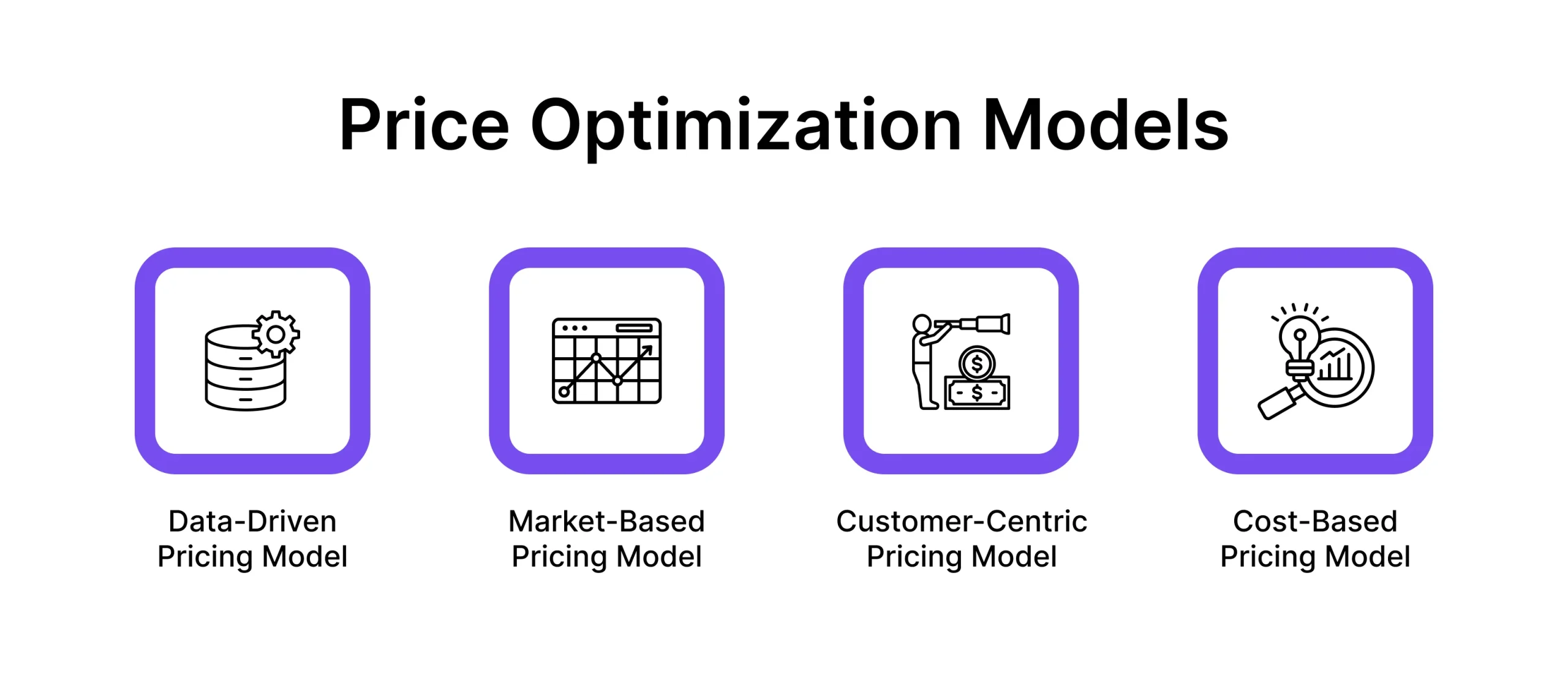Delve into the intricacies of price optimization and its significance in maximizing revenue and customer satisfaction. Discover the essence of price optimization—a strategic approach that transcends instinctual pricing methods.
Explore how sophisticated algorithms analyze customer buying patterns, competitive landscapes, and cost considerations to determine the ideal price for each product. Discover how it drives revenue per sale and enhances customer value perception.
Delve deeper into price optimization strategy, techniques, and models, to craft data-driven pricing strategies. Take your pricing game to the next level and ensure sustained success in today’s dynamic market. Keep reading!
What is Price Optimization?
Imagine: You craft your pricing strategy with conviction and precision, appropriately. You determine the market price of a product that not only improves your profits but also resonates well with your customers and outshines your competition. This is the essence of a price optimization solution. A calculated approach that zeroes in on the ideal price for every item in your inventory.
Abandon the old-school method of relying on instinct or mirroring competitor prices. Price optimization employs sophisticated algorithms to sift through a wealth of data, providing insights into:
- Customer Buying Patterns: Understand the psychology behind your customers’ purchasing decisions. How do they respond to price increases? What price point convinces them to hit ‘buy’? This knowledge allows you to adjust your prices to target the maximum willingness to pay.
- Competitive Analysis: Dive into the pricing strategies of your rivals. Price optimization determines competitor pricing; it analyzes the entire landscape to find where you stand out. It’s not about matching prices but rather outmanoeuvring competition in the value offered.
- Market Dynamics: Gauge the ebb and flow of market tides. How do economic shifts, global trends, and industry updates influence what consumers are willing to spend? Understanding this guides you to set prices that work both today and tomorrow.
- Product Value Perception: Evaluate how customers perceive the value of your products. Price optimization takes into account the quality, features, and benefits of price optimization that elevate your product’s worth in the eyes of consumers.
Benefits of Price Optimization
- Maximize Revenue per Sale: Price optimization enables you to identify the price point where customer demand remains strong while maximizing profit per transaction. This “sweet spot” ensures you capture a fair share of the value your product offers, leading to higher revenue and profitability.
- Enhance Customer Value Perception: Strategic pricing considers the price tag itself, but also the perceived value customers associate with your product. By setting prices that reflect the product’s quality, features, and benefits, you create a sense of fairness and satisfaction for your customers. This fosters trust and loyalty, leading to repeat business.
- Improved Inventory Management: Accurate demand forecasting, a key component of price optimization, enables you to optimize inventory levels. This reduces the risk of stockouts and the associated excess inventory costs. You strike a balance between meeting demand, and minimizing storage and management expenses.
- Data-Driven Promotions and Discounts: Move beyond generic promotions and leverage data to craft targeted offers. By analyzing customer behavior and past sales data, you identify the receptive segments to discounts and personalize promotions for maximum impact. This ensures your promotions are effective in driving sales without sacrificing profit margins.
How Do You Optimize Prices for Your Company?
Stop guessing and start thriving! Price optimization unlocks the perfect price point for every product you sell. Here’s the magic formula:
- Know Your Numbers: Gather data on what customers are willing to pay, market conditions (competitor pricing, seasonal trends), and costs (production, logistics).
- Analyze and Uncover: Use smart tools to analyze this data. Find the price that maximizes profit while considering customer value perception and competitor pricing.
- Take Action & Refine: Don’t be afraid to experiment! Test different price points on a small scale to gauge customer response. Continuously monitor results and refine your pricing strategy for long-term success.
Price Optimization Models
Price optimization models are analytical tools and techniques. They determine the most effective pricing strategies for products and services. These models leverage datasets to predict different pricing strategies impacting demand, revenue, and profitability.
The goal is to identify the optimal price that maximizes a company’s financial objectives while considering market constraints and customer behavior.
 1. Data-Driven Pricing Model
1. Data-Driven Pricing Model
This model relies on extensive data analysis to form pricing strategies. It utilizes big data and advanced analytics to forecast demand and optimize prices.
- Elasticity Analysis Model: Determines how price changes might affect demand by analyzing past sales data. Example: A superstore uses this model to find the optimal price point for dairy products. It adjusts prices based on customer sensitivity to price changes.
- Machine Learning Model: Employs algorithms to learn from historical data and accommodate dynamic pricing. Example: An e-commerce platform uses artificial intelligence and machine learning technology to change prices on electronics based on browsing patterns and inventory levels.
- Predictive Analytics Model: Uses statistical models and forecast techniques to predict future market trends and consumer behavior. Example: A car rental service forecasts peak travel times in various cities. This enables them to adjust their pricing months in advance.
2. Market-Based Pricing Model
This approach sets prices according to external market conditions, focusing on competitors’ pricing and market demand.
- Competitor Analysis Model: Analyzes competitors’ prices to set comparative rates. Example: A coffee shop owner sets its coffee prices slightly lower than a major chain located nearby to attract cost-sensitive customers.
- Value Comparison Model: Prices products based on how customers perceive the value of your product compared to others on the market. Example: A software company prices its productivity suite based on features that exceed those offered by free alternatives.
- Market Penetration Model: Sets an initially low price to quickly gain market share, then gradually increases it. Example: A new streaming service offers an introductory subscription price that is half that of established competitors to quickly draw users.
3. Customer-Centric Pricing Model
This model focuses on creating pricing strategies that align with customer expectations and perceived value.
- Segmented Pricing Model: Differentiates prices for different customer groups based on their specific characteristics and needs. Example: An airline offers discounted rates for seniors and students.
- Personalization Model: Customizes prices for individual customers based on their purchase history and preferences. Example: An online retailer offers personalized discounts to customers based on their previous shopping behaviors.
- Loyalty Pricing Model: Provides special pricing or discounts to loyal customers to encourage continued business. Example: A local gym offers reduced membership fees to members who have been active for over a year.
4. Cost-Based Pricing Model
Sets prices primarily based on the cost of production plus a markup for profit.
- Cost-Plus Pricing Model: Adds a standard markup to the cost of goods. Example: A furniture manufacturer adds a 30% markup to the cost of production to cover expenses and profit.
- Activity-Based Costing Model: More accurately assigns production costs based on the activities that generate them. Example: A custom cake shop uses activity-based costing to price cakes based on the complexity of design and decoration.
- Break-Even Analysis Model: Determines the minimum sales volume needed to cover costs. Example: A startup technology company uses break-even analysis to understand how many units of their new product they need to sell to cover initial production costs.
Price Optimization Techniques
Market Segmentation
This involves dividing the broader market into smaller segments. It is based on demographics, behavior, or needs. Pricing is then tailored to each segment’s specific willingness to pay. It maximizes the revenue from each group.
Loss Leader Strategy
This pricing technique involves selling some products at a loss to attract customers. The key is that while the specific products are sold below cost, they draw in traffic that then purchases other, higher-margin items. Retail giants use this strategy during major sales events to increase sales and clear out inventory.
Behavioral Discounting
This technique uses customer-specific data to offer personalized discounts. These discounts are timed and sized based on the customer’s purchasing behavior. For example, sending a discount offer for a product that a customer has frequently viewed but not purchased prompts a sale. This method increases conversion rates by leveraging personal buying signals and tailoring offers to individual preferences.
Price Sensitivity Analysis
Also known as price elasticity, this analysis highlights how sensitive customers are to changes in price. Knowing how demand varies with price changes enables businesses to set prices at appropriate levels that customers are willing to pay while ensuring profitability.
Calculate the Optimal Price
Begin by compiling essential data: production costs, customer price sensitivity, and competitor pricing. Analyze the impact of price adjustments on sales to determine your price elasticity. Utilize this insight to formulate a pricing strategy—whether it be cost-plus or value-based. Test various price points in the marketplace to refine your approach and achieve optimal results.
Choosing the Right Price Optimization Software
Selecting the appropriate price optimization software is a crucial decision requiring meticulous evaluation. Begin by assessing scalability and industry-specific requirements. Ensure the software accommodates your business needs. Look for features like real-time analytics, demand forecasting, and seamless integration to streamline pricing processes and maximize efficiency.
Gather insights from user reviews and industry peers to understand the performance and suitability. Prioritize engaging in demos or trial periods to evaluate compatibility firsthand. This ensures that your chosen price optimization tools align with your business objectives. It should also empower you to make data-driven pricing decisions confidently.
By following a deliberate selection process, you ensure that your investment in price optimization software contributes to the success of your business.
💡Fact
An EY report suggests that pricing, and product mix account for over 66% of revenue growth for the top 50 Fast-Moving Consumer Goods companies.
Conclusion
Mastering price optimization is paramount for businesses thriving in the competitive landscape. By staying agile and leveraging data-driven strategies, you unlock its full profit potential and secure long-term success.
Take the Next Step
Take charge of your pricing strategy and unlock your business’s potential today. Embrace price optimization to drive revenue. Enhance customer satisfaction, and stay ahead of the competition.
Maximize profits and engage your customers with dynamic price optimization strategies. Leverage artificial intelligence- and machine learning-powered price optimization solutions to rise above your competition.
Frequently Asked Questions
How do you build a price optimization model?
To build a price optimization model, gather data on production costs, customer behavior, and competitor pricing. Then, analyze this data using statistical techniques or machine learning algorithms to identify the optimal pricing strategies.
What are the benefits of price optimization?
Implementing price optimization leads to increased revenue, improved customer satisfaction, and more effective inventory management by aligning pricing strategies with market dynamics and customer preferences.
How often should prices be adjusted using price optimization?
Prices should be adjusted regularly based on changes in market conditions, customer preferences, and cost considerations. Continuous monitoring and analysis are essential to ensure that pricing strategies remain effective and competitive.





